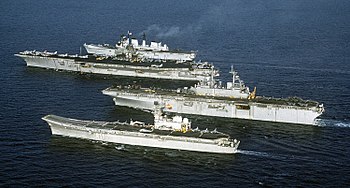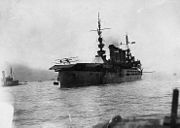Bewise Inc. www.tool-tool.com Reference source from the internet.

An aircraft carrier is a warship designed with a primary mission of deploying and recovering aircraft, acting as a sea-going airbase. Aircraft carriers thus allow a naval force to project air power great distances without having to depend on local bases for staging aircraft operations. They have evolved from wooden vessels used to deploy a balloon into nuclear powered warships that carry dozens of fixed and rotary wing aircraft.
Balloon carriers were the first ships to deploy manned aircraft, used during the 19th and early 20th century, mainly for observation purposes. The 1903 advent of fixed wing airplanes was followed in 1910 by the first flight of such an aircraft from the deck of a US Navy cruiser. Seaplanes and seaplane tender support ships, such as HMS Engadine, followed. The development of flat top vessels produced the first large fleet ships. This evolution was well underway by the mid 1920s, resulting in ships such as the HMS Hermes, Hōshō, and the Lexington class aircraft carriers.
World War II saw the first large scale use and further refinement of the aircraft carrier, spawning several types. Escort aircraft carriers, such as USS Barnes, were built only during World War II. Although some were purpose built, most were converted from merchant ships, and were a stop-gap measure in order to provide air support for convoys and amphibious invasions. Light aircraft carriers, such as USS Independence represented a larger, more "militarized" version of the escort carrier concept. Although the light carriers usually carried the same size air groups as escort carriers, they had the advantage of higher speed as they had been converted from cruisers under construction rather than civilian merchant ships.
Wartime emergencies also saw the creation or conversion of other, unconventional aircraft carriers. CAM ships, like the SS Michael E, were cargo carrying merchant ships which could launch but not retrieve fighter aircraft from a catapult. These vessels were an emergency measure during World War II as were Merchant aircraft carriers (MACs), such as MV Empire MacAlpine, another emergency measure which saw cargo-carrying merchant ships equipped with flight decks. Battlecarriers were created by the Imperial Japanese Navy to partially compensate for the loss of carrier strength at Midway.[citation needed] Two of them were made from Ise class battleships during late 1943. The aft turrets were removed and replaced with a hangar, deck and catapult. The heavy cruiser Mogami concurrently received a similar conversion. This "half and half" design was an unsuccessful compromise, being neither one thing nor the other. Submarine aircraft carriers, such as the French Surcouf, or the Japanese I-400 class submarines, which were capable of carrying 3 Aichi M6A Seiran aircraft, were first built in the 1920s, but were generally unsuccessful at war. Modern navies that operate such ships treat aircraft carriers as the capital ship of the fleet, a role previously played by the battleship. The change, part of the growth of air power as a significant part of warfare, took place during World War II. This change was driven by the superior range, flexibility and effectiveness of carrier-launched aircraft.
Following the war, the scope of carrier operations continued to increase in size and importance. The Supercarrier, typically displacing 75,000 tonnes or greater has been the pinnacle of carrier development since their introduction. Most are powered by nuclear reactors and form the core of a fleet designed to operate far from home. Amphibious assault carriers, such as USS Tarawa or HMS Ocean, which serve the purpose of carrying and landing Marines and operate a large contingent of helicopters for that purpose. They have a secondary capability to operate VSTOL aircraft. Also known as "commando carriers" or "helicopter carriers".
Lacking the firepower of other warships, carriers by themselves are considered vulnerable to attack by other ships, aircraft, submarines or missiles and therefore travel as part of a carrier battle group (CVBG) for their protection. Unlike other types of capital ships in the 20th century, aircraft carrier designs since World War II have been effectively unlimited by any consideration save budgetary, and the ships have increased in size to handle the larger aircraft: The large, modern Nimitz class of United States Navy carriers has a displacement nearly four times that of the World War II-era USS Enterprise yet its complement of aircraft is roughly the same, a consequence of the steadily increasing size of military aircraft over the years.[citation needed]
[edit] History and milestones
Though aircraft carriers are given their definition with respect to fixed-wing aircraft, the first known instance of using a ship for airborne operations occurred in 1806, when the British Royal Navy's Lord Thomas Cochrane launched kites from the 32-gun frigate HMS Pallas in order to drop propaganda leaflets on the French territory.[citation needed]
[edit] Balloon carriers
On 12 July 1849, the Austrian Navy ship Vulcano launched a manned hot air balloon in order to drop bombs on Venice, although the attempt failed due to contrary winds.[1]
Later, during the American Civil War, about the time of the Peninsula Campaign, gas-filled balloons were being used to perform reconnaissance on Confederate positions. The battles soon turned inland into the heavily forested areas of the Peninsula, however, where balloons could not travel. A coal barge, the George Washington Parke Custis, was cleared of all deck rigging to accommodate the gas generators and apparatus of balloons. From the GWP Prof. Thaddeus S. C. Lowe, Chief Aeronaut of the Union Army Balloon Corps, made his first ascents over the Potomac River and telegraphed claims of the success of the first aerial venture ever made from a water-borne vessel. Other barges were converted to assist with the other military balloons transported about the eastern waterways. It is only fair to point out in deference to modern aircraft carriers that none of these Civil War crafts had ever taken to the high seas.
Balloons launched from ships led to the development of balloon carriers, or balloon tenders, during World War I, by the navies of Great Britain, France, Germany, Italy, Russia, and Sweden. About ten such "balloon tenders" were built, their main objective being aerial observation posts. These ships were either decommissioned or converted to seaplane tenders after the war.
[edit] Seaplane carriers

The invention of the seaplane in March 1910 with the French Le Canard led to the earliest development of a ship designed to carry airplanes, albeit equipped with floats: in December 1911 appears the French Navy La Foudre, the first seaplane carrier, and the first known carrier of airplanes. Commissioned as a seaplane tender, and carrying float-equipped planes under hangars on the main deck, from where they were lowered on the sea with a crane, she participated in tactical exercises in the Mediterranean in 1912. La Foudre was further modified in November 1913 with a 10 meter long flat deck to launch her seaplanes.[2]
HMS Hermes, temporarily converted as an experimental seaplane carrier in April-May 1913, is also one of the first seaplane carriers, and the first experimental seaplane carrier of the British Navy. She was originally laid down as a merchant ship, but was converted on the building stocks to be a seaplane carrier for a few trials in 1913, before being converted again to a cruiser, and back again to a seaplane carrier in 1914. She was sunk by a German submarine in October 1914. The first seaplane tender of the US Navy was the USS Mississippi, converted to that role in December 1913.[3]
Many cruisers and capital ships of the inter-war years often carried a catapult launched seaplane for reconnaissance and spotting the fall of the guns. It was launched by a catapult and recovered by crane from the water after landing. These were highly successful during World War II; there were many notable successes early in the war as shown by HMS Warspite’s float equipped Swordfish during the Second Battle of Narvik in 1940, where it spotted for the guns of the British warships, ensuring all seven German destroyers were sunk, and sinking the German submarine U-64 with its own bombs.[4] The Japanese Rufe floatplane derived from the Zero was a formidable fighter with only a slight loss in flight performance, one of their pilots scored 26 kills in the A6M2-N Rufe; a score only bettered by a handful of American pilots throughout WW2.[citation needed] Other Japanese seaplanes launched from tenders and warships sank merchant ships and small-scale ground attacks. The culmination of the type was the American 300+ mph (480 km/h) Curtiss SC Seahawk which was actually a fighter aircraft like the Rufe in addition to a two-seat gunnery spotter and transport for an injured man in a litter.[citation needed]Spotter seaplane aircraft on U.S. Navy cruisers and battleships were in service until 1949. Seaplane fighters were considered poor combat aircraft compared to their carrier-launched brethren; they were slower due to the drag of their pontoons or boat hulls. Contemporary propeller-driven, land-based fighter aircraft were much faster (450-480 mph / 720-770 km/h as opposed to 300-350 mph / 480-560 km/h) and more heavily armed.[citation needed] The Curtiss Seahawk only had two 0.50 inch (12.7 mm) calibre machine guns compared to four 20 mm cannon in the Grumman F8F Bearcat or four 0.50 (12.7 mm) cal machine guns plus two 20 mm cannon in the Vought F4U Corsair. Jet aircraft of just a few years later were faster still (500+ mph) and still better armed, especially with the development of air to air missiles in the early to mid 1950s.
[edit] Genesis of the flat-deck carrier
As heavier-than-air aircraft developed in the early 20th century various navies began to take an interest in their potential use as scouts for their big gun warships. In 1909 the French inventor Clément Ader published in his book "L'Aviation Militaire" the description of a ship to operate airplanes at sea, with a flat flight deck, an island superstructure, deck elevators and a hangar bay.[5] That year the US Naval Attaché in Paris sent a report on his observations.[6]
A number of experimental flights were made to test the concept. Eugene Ely was the first pilot to launch from a stationary ship in November 1910. He took off from a structure fixed over the forecastle of the US armored cruiser USS Birmingham at Hampton Roads, Virginia and landed nearby on Willoughby Spit after some five minutes in the air.
On January 18, 1911 he became the first pilot to land on a stationary ship. He took off from the Tanforan racetrack and landed on a similar temporary structure on the aft of USS Pennsylvania anchored at the San Francisco waterfront—the improvised braking system of sandbags and ropes led directly to the arrestor hook and wires described above. His aircraft was then turned around and he was able to take off again. Commander Charles Rumney Samson, RN, became the first airman to take off from a moving warship on May 2, 1912. He took off in a Short S27 from the battleship HMS Hibernia while she steamed at 10.5 knots (19 km/h) during the Royal Fleet Review at Weymouth.
[edit] World War I

The first strike from a carrier against a land target as well as a sea target took place in September 1914 when the Imperial Japanese Navy seaplane carrier Wakamiya conducted the world's first naval-launched air raids[7] from Kiaochow Bay during the Battle of Tsingtao in China.[8] The four Maurice Farman seaplanes bombarded German-held land targets (communication centers and command centers) and damaged a German minelayer in the Tsingtao peninsula from September until November 6, 1914, when the Germans surrendered.[9] On the Western front the first naval air raid occurred on December 25, 1914 when twelve seaplanes from HMS Engadine, Riviera and Empress (cross-channel steamers converted into seaplane carriers) attacked the Zeppelin base at Cuxhaven. The attack was not a complete success, although a German%





 留言列表
留言列表
